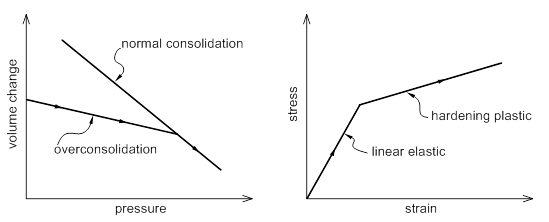A
model used to simulate clay materials. The general relationship
between volume change and pressure in clay ground can
be expressed using the concept of normal consolidation
line and over-consolidation line. The over-consolidation
line is also called the dwelling line and the stress increase
(load) follows along over-consolidation line to the normal
consolidation line. Passing the intersection with additional
stress increase makes the stress state move down along
the normal consolidation line. This has similar characteristics
to the stress-strain curve of an elasto-hardening plastic
model. Hence, the initial linear elastic region of the
over-consolidation line can be corresponded to the hardening
plastic region of the normal consolidation line.

<Volume-Pressure vs Stress-Strain
relationship>
To
use the Modified Cam Clay model, the initial void ratio,
initial stress and initial Pre-consolidation pressure
need to be defined. The Pre-consolidation pressure can
be directly entered, or calculated from the initial stress
and Over Consolidation Ratio (OCR). When both the OCR
and Pre-consolidation pressure are entered, the Pre-consolidation
pressure is preferentially used.
The
main nonlinear parameters of the Modified Cam Clay model
are as follows.

Symbol |
Definition |

|
Over-consolidation
line slope |

|
Normal
consolidation line slope |

|
Critical
state line slope |
The material properties of the ground are generally
obtained from the 1-dimensional consolidation test and
the Compression index  and Swelling
index and Swelling
index  can be obtained from the
void ratio ( can be obtained from the
void ratio ( ) -
) -  graph. The Compression index
and Swelling index are related to the Normal consolidation
line slope graph. The Compression index
and Swelling index are related to the Normal consolidation
line slope  and
Over-consolidation line slope and
Over-consolidation line slope  by the
following equations. by the
following equations.

The
Critical state line slope  can be assumed
from the effective shear resistance angle (shear resistance
angle from drained test). can be assumed
from the effective shear resistance angle (shear resistance
angle from drained test).

 : Interior friction
angle from triaxial compression test : Interior friction
angle from triaxial compression test
The
OCR value can be used to calculate the stress distribution
of the in-situ state from the current loaded stress distribution.
The stress for each depth is calculated from the entered
OCR and because the ground surface stress can be underestimated
than the actual initial stress, the Pc (Pre-consolidation
pressure) can be directly defined. When both the OCR and
Pre-consolidation pressure are entered, the Pre-consolidation
pressure is preferentially used in the analysis.
When
the Pc is entered, the internal solver studies whether
the Pc and in-situ stress state satisfy the yield function.
If it does not, the Pc is recalculated.
Allowable Tensile Stress
MCC
material models fundamentally do not allow tensile stress
in the failure criteria (stress-strain relationship).
However, various conditions can generate tensile stress,
such as the heaving of neighboring ground due to embankment
load during consolidation or uplift due to excavation.
To overcome the material model limits and increase the
applicability, analysis on tensile stress within the 'allowable
tensile stress' range can be conducted.
The
size of the allowable tensile stress is not specified,
and requires repeated analysis to input a larger value
than the tensile stress created from the overburden load
(embankment) or failure behavior. Hence, the allowable
tensile stress value needs to be set, to prevent divergence
and halting of analysis results due to tensile failure
during analysis.
Hence,
the allowable tensile stress value needs to be set, to
prevent divergence and halting of analysis results due
to tensile failure during analysis.
However,
when directly entering the pc (pre-consolidation load),
the allowable tensile stress cannot surpass the pc value.
When defining using the OCR, the pc value is automatically
calculated internally by considering the size of the input
allowable tensile stress. |


